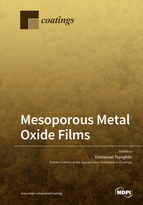Mesoporous Metal Oxide Films
A special issue of Coatings (ISSN 2079-6412).
Deadline for manuscript submissions: closed (31 January 2020) | Viewed by 39618
Special Issue Editor
Interests: analytical chemistry; metal oxide films; coatings; colloids; nanoparticles; nanocomposites; perovskites; protein immobilization; bioelectrochemistry; electrochemical sensors and biosensors; cyclic voltammetry and chronoamperometry; optical biosensors; transient spectroscopy; potein/electrode interactions
Special Issues, Collections and Topics in MDPI journals
Special Issue Information
Dear Colleagues,
I would like to invite you to submit your work to this Special Issue on "Mesoporous Metal Oxide Films”. Mesoporous metal oxide films exhibit excellent physicochemical properties, such as large band gap, large surface area, controlable pore size and morphology, good thermal and chemical stabilities, unique optical and electrical properties, non-toxicity and low costs. Various techniques have been developed for the preparation of such films, including sol-gel screen printing, dip coating, spin coating, sputtering spray pyrolysis, atomic layer deposition, electrodeposition and anodic oxidation. A great deal of effort has been made to simplify these methods in order to prepare films faster and in a more reproducible way. Over the last 20 years, the films have been used for many applications ranging from dye-sensitized solar cells, adsorption and separation, chemical and biochemical sensors, gas sensors, drug delivery, electrochromic windows, photo and/or electrocatalysis and energy storage devices such as rechargeable batteries and electrochemical supercapacitors. More recently these materilas have beed used as the scaffold for the development of perovskite solar cells. This Special Issue of Coatings focuses on all these areas of application. Our aim is to present the most important developments in this fast-moving field, from the leading groups around the world.
Topics of interest include, but are not limited to:
- Novel approaches of mesoporous metal oxide films related to fabrication and characterization methods;
- Understand the optical and electronic properties of the films;
- Their use for energy conersion and storage, for solar cells, as electrode material for lithium ion baterries and for electrochemical supercapacitors;
- Gas sensing, studying their excellent sensing capabilities;
- Their use as substrates for the immobilization of molecules or biomolecules for the development of electrochemical or optical sensors and biosensors;
- Their use for adsorption and separation, as stationary phase in liquid chromatography or adsorbents for heavy metals, anions, organic pollutants and gases;
- Their use as catalysts or catalyst supports, for studying redox reactions, for phtocatalytic applications etc.;
- Their doping with nanoparticles, perovskites or other materials for multicolor photochromism, the development of more efficient solar cells or other applications.
Dr. Topoglidis Manos
Guest Editor
Manuscript Submission Information
Manuscripts should be submitted online at www.mdpi.com by registering and logging in to this website. Once you are registered, click here to go to the submission form. Manuscripts can be submitted until the deadline. All submissions that pass pre-check are peer-reviewed. Accepted papers will be published continuously in the journal (as soon as accepted) and will be listed together on the special issue website. Research articles, review articles as well as short communications are invited. For planned papers, a title and short abstract (about 100 words) can be sent to the Editorial Office for announcement on this website.
Submitted manuscripts should not have been published previously, nor be under consideration for publication elsewhere (except conference proceedings papers). All manuscripts are thoroughly refereed through a single-blind peer-review process. A guide for authors and other relevant information for submission of manuscripts is available on the Instructions for Authors page. Coatings is an international peer-reviewed open access monthly journal published by MDPI.
Please visit the Instructions for Authors page before submitting a manuscript. The Article Processing Charge (APC) for publication in this open access journal is 2600 CHF (Swiss Francs). Submitted papers should be well formatted and use good English. Authors may use MDPI's English editing service prior to publication or during author revisions.






